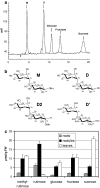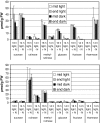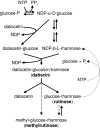Two novel disaccharides, rutinose and methylrutinose, are involved in carbon metabolism in Datisca glomerata
- PMID: 19915863
- PMCID: PMC2806534
- DOI: 10.1007/s00425-009-1049-5
Two novel disaccharides, rutinose and methylrutinose, are involved in carbon metabolism in Datisca glomerata
Erratum in
- Planta. 2010 Feb;231(3):523
Abstract
Datisca glomerata forms nitrogen-fixing root nodules in symbiosis with soil actinomycetes from the genus Frankia. Analysis of sugars in roots, nodules and leaves of D. glomerata revealed the presence of two novel compounds that were identified as alpha-L-rhamnopyranoside-(1 --> 6)-D-glucose (rutinose) and alpha-L-rhamnopyranoside-(1 --> 6)-1-O-beta-D-methylglucose (methylrutinose). Rutinose has been found previously as a/the glycoside part of several flavonoid glycosides, e.g. rutin, also of datiscin, the main flavonoid of Datisca cannabina, but had not been reported as free sugar. Time course analyses suggest that both rutinose and methylrutinose might play a role in transient carbon storage in sink organs and, to a lesser extent, in source leaves. Their concentrations show that they can accumulate in the vacuole. Rutinose, but not methylrutinose, was accepted as a substrate by the tonoplast disaccharide transporter SUT4 from Arabidopsis. In vivo (14)C-labeling and the study of uptake of exogenous sucrose and rutinose from the leaf apoplast showed that neither rutinose nor methylrutinose appreciably participate in phloem translocation of carbon from source to sink organs, despite rutinose being found in the apoplast at significant levels. A model for sugar metabolism in D. glomerata is presented.
Figures






Similar articles
-
Plasmodesmata distribution and sugar partitioning in nitrogen-fixing root nodules of Datisca glomerata.Planta. 2011 Jan;233(1):139-52. doi: 10.1007/s00425-010-1285-8. Epub 2010 Oct 12. Planta. 2011. PMID: 20938679 Free PMC article.
-
Carbon source-sink relationship in Arabidopsis thaliana: the role of sucrose transporters.Planta. 2018 Mar;247(3):587-611. doi: 10.1007/s00425-017-2807-4. Epub 2017 Nov 14. Planta. 2018. PMID: 29138971 Free PMC article.
-
Truncated hemoglobins in actinorhizal nodules of Datisca glomerata.Plant Biol (Stuttg). 2007 Nov;9(6):776-85. doi: 10.1055/s-2007-965258. Epub 2007 Aug 7. Plant Biol (Stuttg). 2007. PMID: 17682965
-
Symbiosis between Frankia and actinorhizal plants: root nodules of non-legumes.Indian J Exp Biol. 2003 Oct;41(10):1165-83. Indian J Exp Biol. 2003. PMID: 15242283 Review.
-
Understanding and manipulating sucrose phloem loading, unloading, metabolism, and signalling to enhance crop yield and food security.J Exp Bot. 2014 Apr;65(7):1713-35. doi: 10.1093/jxb/ert416. Epub 2013 Dec 17. J Exp Bot. 2014. PMID: 24347463 Review.
Cited by
-
Comparison of the nodule vs. root transcriptome of the actinorhizal plant Datisca glomerata: actinorhizal nodules contain a specific class of defensins.PLoS One. 2013 Aug 29;8(8):e72442. doi: 10.1371/journal.pone.0072442. eCollection 2013. PLoS One. 2013. PMID: 24009681 Free PMC article.
-
Plasmodesmata distribution and sugar partitioning in nitrogen-fixing root nodules of Datisca glomerata.Planta. 2011 Jan;233(1):139-52. doi: 10.1007/s00425-010-1285-8. Epub 2010 Oct 12. Planta. 2011. PMID: 20938679 Free PMC article.
-
Evolution of plant sucrose uptake transporters.Front Plant Sci. 2012 Feb 15;3:22. doi: 10.3389/fpls.2012.00022. eCollection 2012. Front Plant Sci. 2012. PMID: 22639641 Free PMC article.
-
Versatile redox chemistry complicates antioxidant capacity assessment: flavonoids as milieu-dependent anti- and pro-oxidants.Int J Mol Sci. 2013 Jun 4;14(6):11830-41. doi: 10.3390/ijms140611830. Int J Mol Sci. 2013. PMID: 23736691 Free PMC article.
-
Distinctive Patterns of Flavonoid Biosynthesis in Roots and Nodules of Datisca glomerata and Medicago spp. Revealed by Metabolomic and Gene Expression Profiles.Front Plant Sci. 2018 Oct 10;9:1463. doi: 10.3389/fpls.2018.01463. eCollection 2018. Front Plant Sci. 2018. PMID: 30364174 Free PMC article.
References
-
- Altschul SF, Gish W, Miller W, Myers EW, Lipman DJ. Basic local alignment search tool. J Mol Biol. 1990;215:304–310. - PubMed
-
- Avigad G. Sucrose and other disaccharides. In: Loewus FA, Tanner W, editors. Plant carbohydrates I: intracellular carbohydrates. Encyclopedia of plant physiology, volume 13A. Berlin: Springer; 1982. pp. 217–347.
-
- Bar-Peled M, Lewinsohn E, Fluhr R, Gressel J. UDP-rhamnose:flavanone-7-O-glucoside-2′α″-O-rhamnosyltransferase. Purification and characterization of an enzyme catalyzing the production of bitter compounds in Citrus. J Biol Chem. 1991;226:20953–20959. - PubMed
Publication types
MeSH terms
Substances
LinkOut - more resources
Full Text Sources
Molecular Biology Databases

